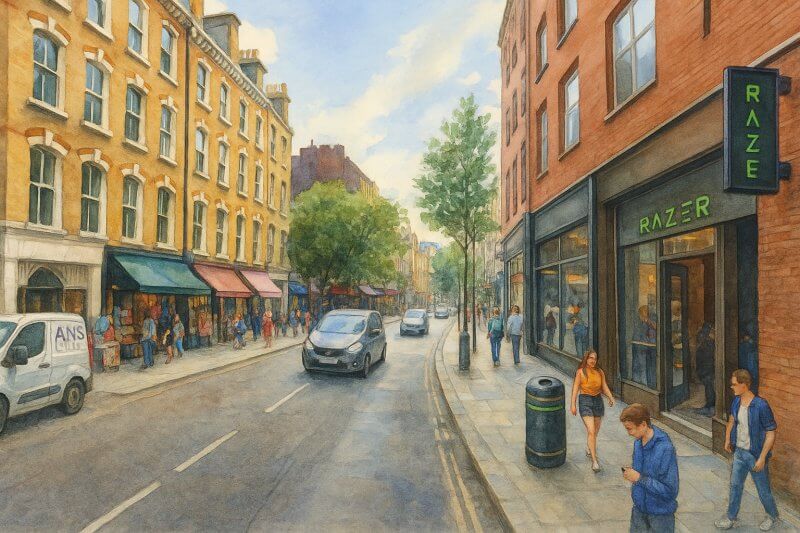
The West End of London
Geographically, it sits to the west of the historic City of London, and to the north of the River Thames. It includes some of the capital's most iconic districts and overlaps with several well-known neighbourhoods, including:
- Soho
- Covent Garden
- Mayfair
- St James's
- Fitzrovia
- Marylebone (partially)
Size and Demographics
The West End is not formally defined by administrative boundaries, so its exact size varies depending on the source. However, it generally spans about 8–10 square kilometres.Its population is relatively low - estimated at under 30,000 permanent residents - especially when compared to its daytime population, which swells into the hundreds of thousands due to tourism, commerce, and entertainment.
This lower residential population is largely because the area is dominated by commercial buildings, theatres, shops, offices, and government buildings, rather than housing.
As a result, the West End has one of the highest per capita incomes in the UK, due to the concentration of high-earning professionals, wealthy residents, and luxury retail. However, this is offset by areas such as Soho, which have historically been more mixed in terms of affluence.
Map of West End, London
History of the West End
The West End began to develop in earnest in the late 17th century, as London expanded westwards beyond the confines of the old City.The aristocracy, seeking a healthier and more pleasant environment than the polluted City, built grand townhouses and squares in this area. From the 18th century onwards, the West End became a fashionable place for the wealthy elite to live, shop, and socialise.
By the 19th century, the area had become synonymous with entertainment, with the construction of theatres, music halls, and the growth of London's cultural institutions. Over time, it evolved into the entertainment and commercial powerhouse it is today.
Origin of the Name "West End"
The term "West End" has been used since at least the early 19th century to distinguish the fashionable and prosperous western part of central London from the older and more commercial East End.The name stems simply from its location relative to the City of London. It became commonly used to refer not just to geography, but to lifestyle, wealth, and culture.

Painting of West End (View full-size image here)
The Character of the West End
The West End is overwhelmingly commercial in nature, filled with shops, restaurants, hotels, cinemas, and theatres. It is also the centre of London's theatre district, often called "Theatreland".Residential areas do exist, particularly in Mayfair and Fitzrovia, where grand Georgian and Victorian homes are now among the most expensive real estate in the world.
There is very little industrial activity here. Instead, the area is known for its cultural affluence, buzzing nightlife, and global appeal. It is also a political and media hub, housing several embassies, government departments, and media offices.
Major Roads of the West End
Some of London's most famous roads run through the West End. These include:- Oxford Street - one of the busiest shopping streets in Europe
- Regent Street - known for elegant architecture and flagship stores
- Shaftesbury Avenue - the heart of Theatreland
- Piccadilly - home to luxury shops and the Royal Academy
- The Strand - connecting Trafalgar Square to the City
- Charing Cross Road - lined with bookshops and theatres
Major Buildings and Sights
The West End is packed with landmarks and attractions. Notable sites include:- Piccadilly Circus - famous for its lights and as a meeting point
- Leicester Square - a hub for film premieres and cinemas
- Trafalgar Square - featuring Nelson's Column and the National Gallery
- Covent Garden - known for street performers, markets, and boutique shopping
- Soho - a lively area for food, nightlife, and creativity
- Royal Opera House - a world-class venue for opera and ballet
- Liberty London - a Tudor-style department store beloved by locals
Nearest London Underground Stations
The West End is exceptionally well-served by the London Underground. Key stations include:- Oxford Circus - Bakerloo, Central, and Victoria lines
- Piccadilly Circus - Piccadilly and Bakerloo lines
- Leicester Square - Piccadilly and Northern lines
- Tottenham Court Road - Central, Northern, and Elizabeth lines
- Charing Cross - Bakerloo and Northern lines, plus National Rail
- Covent Garden - Piccadilly line
Fun Fact: Where the World Premieres
The West End is sometimes referred to as "the Broadway of London", and it hosts more theatrical productions than anywhere else in Europe.Leicester Square is also the home of red-carpet film premieres. If you're in town, you just might catch a Hollywood star attending a gala screening at the Odeon or Vue cinemas!
In Summary
The West End is a dazzling district at the heart of London's culture, commerce, and creativity. Whether you're drawn by world-class theatre, historic landmarks, luxurious shopping, or simply the vibrant street life, this iconic area has something for everyone.From the elegance of Mayfair to the buzz of Soho, and the lights of Piccadilly to the grandeur of Trafalgar Square, the West End truly encapsulates the spirit of London.